Factors Affecting the Efficiency of Hydrophobic Coatings—Experience from Application on Sandstone
Abstract
:1. Introduction
2. Materials and Methods
2.1. Materials
2.2. Methods
- mt (g) is the mass of the sample determined at the time t (s) since the first contact with water,
- md (g) is the mass of the dry sample, and
- A (m2) is the area of the sample base in contact with water.
- mmax (g) is the mass of the sample saturated with water only through capillary rise to a constant mass and
- md (g) is the mass of the dry sample.
- msat (g) is the mass of the sample saturated with water to the constant mass and
- md (g) is the mass of the dry sample.
- NWACt and NWAIt (%) is NWAC or NWAI of treated sample and
- NWACu and NWAIu (%) is NWAC or NWAI of untreated sample.
3. Results
3.1. Application and Penetration of Coatings
3.2. Results of the Water Absorption Tests
3.2.1. Efficiency of the Antipluviol S
3.2.2. Efficiency of the Funcosil SNL
4. Discussion
5. Conclusions
Supplementary Materials
Author Contributions
Funding
Institutional Review Board Statement
Informed Consent Statement
Data Availability Statement
Conflicts of Interest
References
- Winkler, E.M. Stone in Architecture. Properties, Durability, 3rd ed.; Springer: New York, NY, USA, 1997; p. 313. [Google Scholar]
- ICOMOS-ISCS—International Council on Monuments and Sites—International Scientific Committee for Stone. Illustrated Glossary on Stone Deterioration Patterns; ICOMOS-ISCS: Champigny/Marne, France, 2008; Available online: https://www.icomos.org/publications/monuments_and_sites/15/pdf/Monuments_and_Sites_15_ISCS_Glossary_Stone.pdf (accessed on 29 April 2024).
- Alves, C.; Figueiredo, C.A.M.; Sanjurjo-Sánchez, J.; Hernández, A.C. Effects of Water on Natural Stone in the Built Environment—A Review. Geosciences 2021, 11, 459. [Google Scholar] [CrossRef]
- Sanjurjo-Sánchez, J.; Alves, C. Decay effects of pollutants on stony materials in the built environment. Environ. Chem. Lett. 2011, 10, 131–143. [Google Scholar] [CrossRef]
- Cappelletti, G.; Fermo, P.; Camiloni, M. Smart hybrid coatings for natural stones conservation. Prog. Org. Coat. 2015, 78, 511–516. [Google Scholar] [CrossRef]
- Soulious, V.; de Place Hansen, E.J.; Feng, C.; Janssen, H. Hygric behavior of hydrophobized brick and mortar samples. Build. Environ. 2020, 176, 511–516. [Google Scholar] [CrossRef]
- Wendler, E.; Snethlage, R. Durability of hydrophobing treatments of natural stone buildings. In The Engineering Geology of Ancient Works, Monuments and Historical Sites; Marinos, P.G., Koukis, G., Eds.; A.A.Balkema: Rotterdam, The Netherlands; Brookfield, WI, USA, 1988; pp. 945–952. [Google Scholar]
- Snethlage, R.; Auras, M.; Leisen, H.; Sattler, L.; Wendler, E. Alte Pinakothek München. In Denkmalpflege und Naturwissenschaft Natursteinkonservierung I; Snethlage, R., Ed.; Ernst & Sohn: Berlin, Germany, 1996; pp. 153–194. [Google Scholar]
- Meinhardt-Degen, J.; Snethlage, R. Durability of hydrophobic treatment on sandstone facades—Investigations of the necessity and effects of retreatment. In Proceedings of the 10th International Congress on Deterioration and Conservation of Stone; Kwiatkowski, D., Löfvendahl, R., Eds.; ICOMOS: Stockholm, Sweden, 2004; pp. 347–354. [Google Scholar]
- Bromblet, P. Conservation of limestone in France. What do we know about the long-term performance of treatments. In Proceedings of the Domstiftung Regensburg Turm Fassade Portal, Regensburg, Germany, 27–30 September 2000; Schnell & Steiner: Regensburg, Germany, 2000; pp. 127–130. [Google Scholar]
- Siegesmund, S.; Snethlage, R. (Eds.) Stone in Architecture. Properties, Durability, 4th ed.; Springer: Berlin/Heidelberg, Germany, 2011; 552p. [Google Scholar]
- Durmeková, T.; Adamcová, R.; Maľa, M.; Grand, P. Efficiency of protective coating applied on a highly porous decorative tuf. Acta Geol. Slovaca 2021, 13, 85–94. [Google Scholar]
- Zhao, J.; Meissener, F. Experimental investigation of moisture properties of historic building material with hydrophobization treatment. Energy Procedia 2017, 132, 261–266. [Google Scholar] [CrossRef]
- Hansen, T.K.; Bjarlov, S.P.; Peuhkuri, R.H.; Hansen, K.K. Performance of hydrophobized solid masonry—Experimental approach. Constr. Build. Mater. 2018, 188, 695–708. [Google Scholar] [CrossRef]
- Bao, J.; Li, S.; Zhang, P.; Xue, S.; Cui, Y.; Zhao, T. Influence of exposure environments and moisture content on water repellency of surface impregnation of cement-based materials. J. Mater. Res. Technol. 2020, 9, 12115–12125. [Google Scholar] [CrossRef]
- Snethlage, R.; Sterflinger, K. Stone Conservation. In Stone in Architecture. Properties, Durability, 4th ed.; Siegesmund, S., Snethlage, R., Eds.; Springer: Berlin/Heidelberg, Germany, 2011; pp. 411–544. [Google Scholar]
- Syed, A.; Donadio, M. Silane sealers/Hydrophobic impregnation—The European perspective. Concr. Repair Bull. 2013, 12, 1–6. [Google Scholar]
- Johansson, K.; Christophliemk, H.; Johansson, C.; Järnström, L.; Jönsson, L. The effects of coating structure and water-holding capacity on the oxygen-scavenging ability of enzymes embedded in the coating layer. TAPPI J. 2013, 12, 43–51. [Google Scholar] [CrossRef]
- Dinçer, I.; Bostanci, M. Capillary water absorption characteristics of some Cappadocian ignimbrites and the role of capillarity on their deterioration. Environ. Earth Sci. 2019, 78, 7. [Google Scholar] [CrossRef]
- Dunčková, L.; Durmeková, T.; Adamcová, R.; Bednarik, M. Laboratory Assessment of Selected Protective Coatings Applied on Two Sandstone Types. Coatings 2022, 12, 761. [Google Scholar] [CrossRef]
- Pivko, D. Použitie hořického pískovce a iných dekoračných kameňov Česka na Slovensku. Zpravodaj—Svaz kameníků a Kamenosochařů České Republiky z.s. 2019, 2, 10–14. [Google Scholar]
- Hasníková, H. Testing mechanical properties of natural stones used as a building material. Eng. Mech. 2013, 20, 427–435. [Google Scholar]
- Ingram, L.L.; Howard, L.; Furr, H.L. Effect of Surface Coatings and Bonded Overlays on Moisture Migration; Texas Transportation Institute, Texas A&M University: College Station, TX, USA, 1971; 40p, Available online: http://tti.tamu.edu/documents/130-6.pdf (accessed on 15 April 2024).
- Pan, X.; Shi, Z.; Shi, C.; Ling, T.C.H.; Li, N. A review on concrete surface treatment Part I: Types and mechanisms. Constr. Build. Mater. 2017, 132, 578–590. [Google Scholar] [CrossRef]
- EN 1925: 1999; Natural Stone Test Methods. Determination of Water Absorption Coefficient by Capillarity. CEN-CENELEC Management Centre: Brussels, Belgium, 1999.
- EN 13755: 2008; Natural Stone Test Methods. Determination of Water Absorption at Atmospheric Pressure. CEN-CENELEC Management Centre: Brussels, Belgium, 2008.
- Color, M. Geological Rock-Color Chart with Genuine Munsell Color Chips; Produced by Munsell Color; Geological Society of America: Boulder, CO, USA, 2011. [Google Scholar]
- Dong, H.; Gao, P.; Ye, G. Characterization and comparison of capillary pore structures of digital cement pastes. Mater. Struct. 2017, 50, 154. [Google Scholar] [CrossRef]
- Ren, K.; Kagi, D. Evaluation of an Oil and Water Repellent on Masonry Substrates. In Proceedings of the Hydrophobe VIII, Honkgong, China, 7–9 December 2017; pp. 44–52. Available online: http://www.hydrophobe.org/pdf/hongkong/A-1-3.pdf (accessed on 20 October 2023).
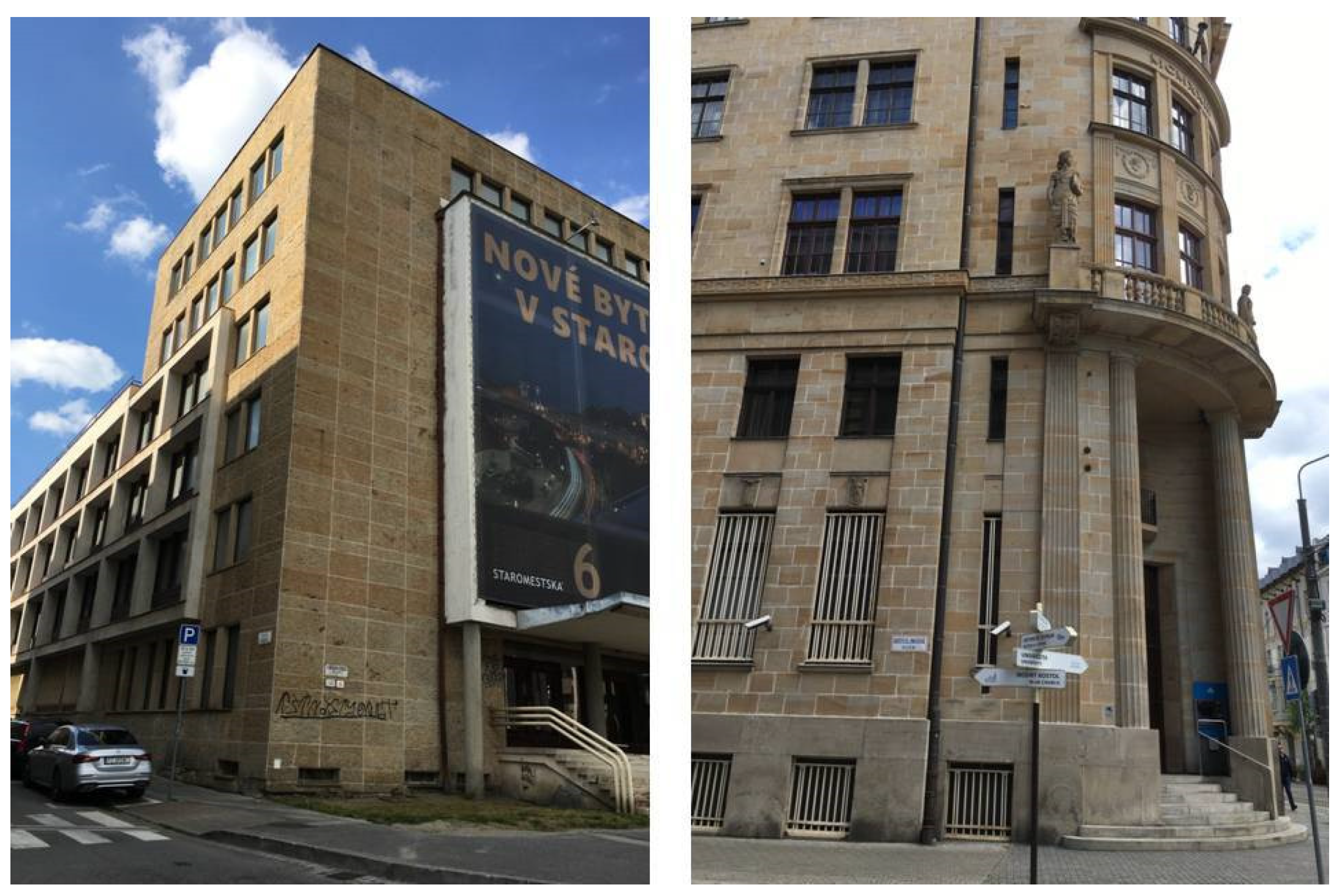
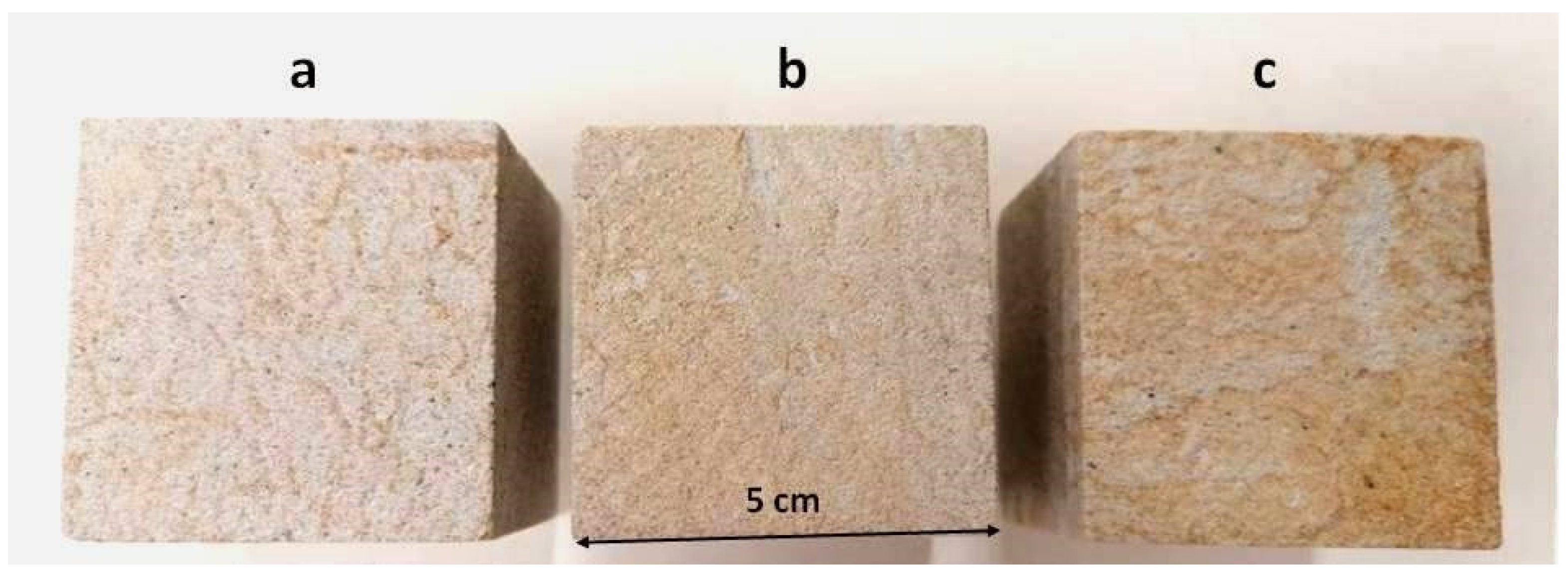
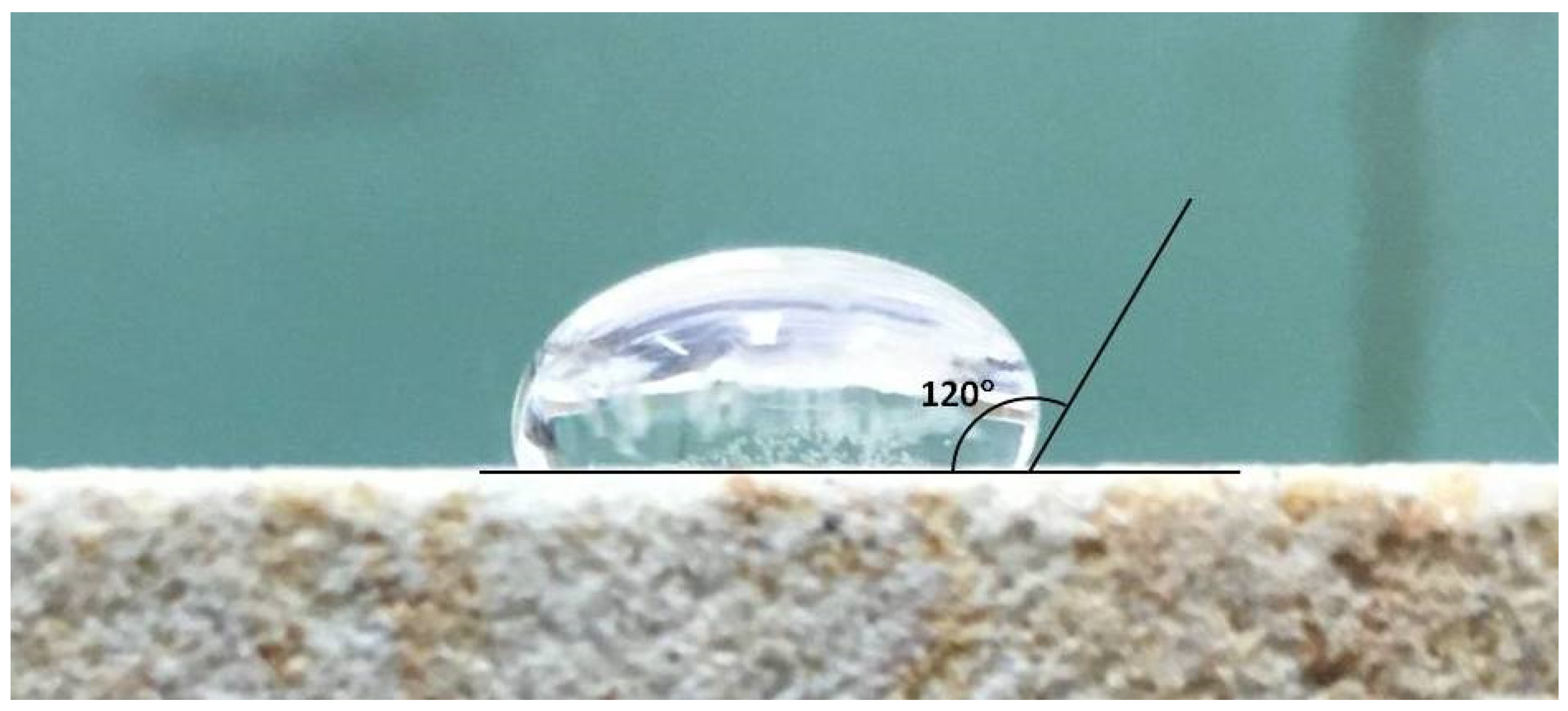
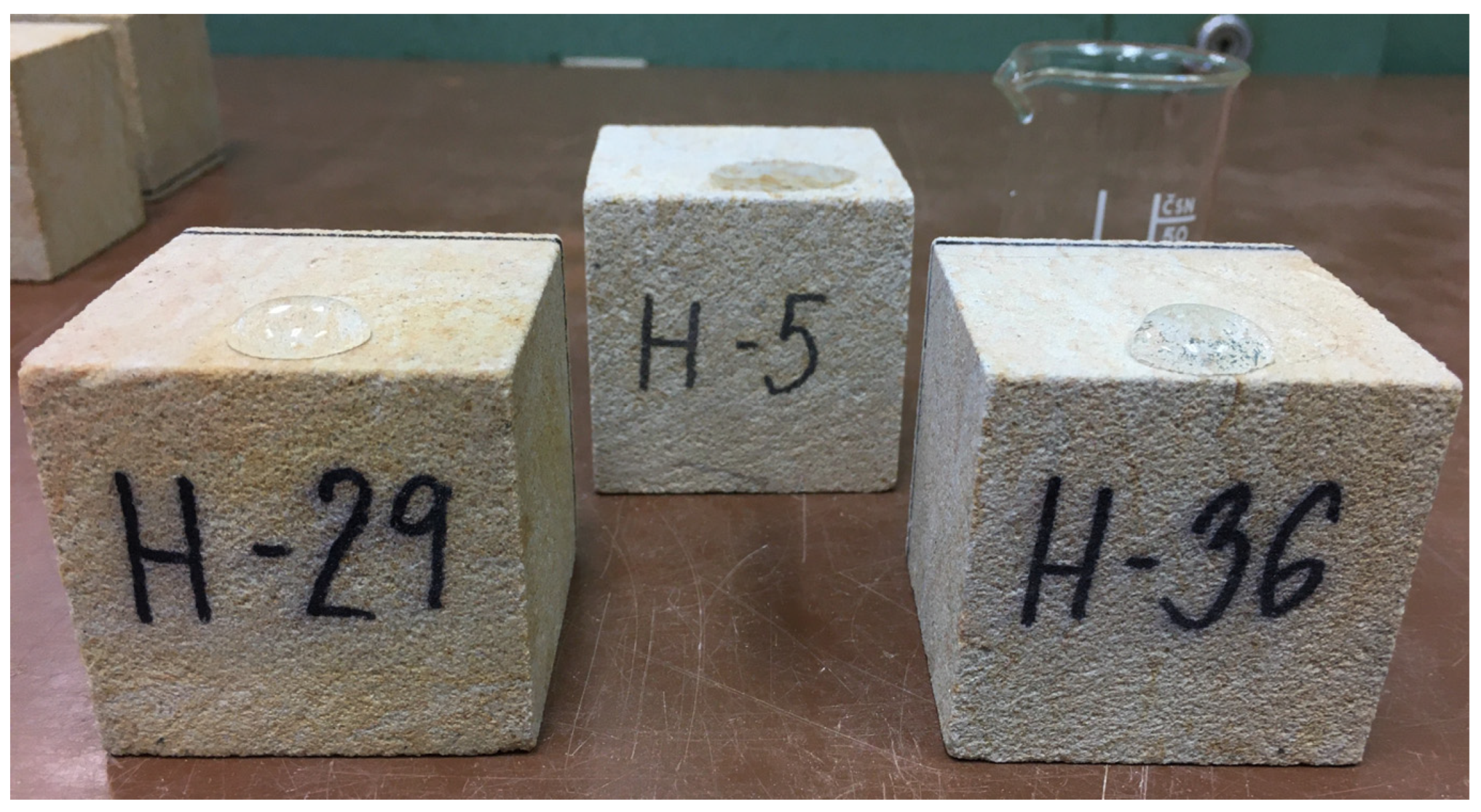
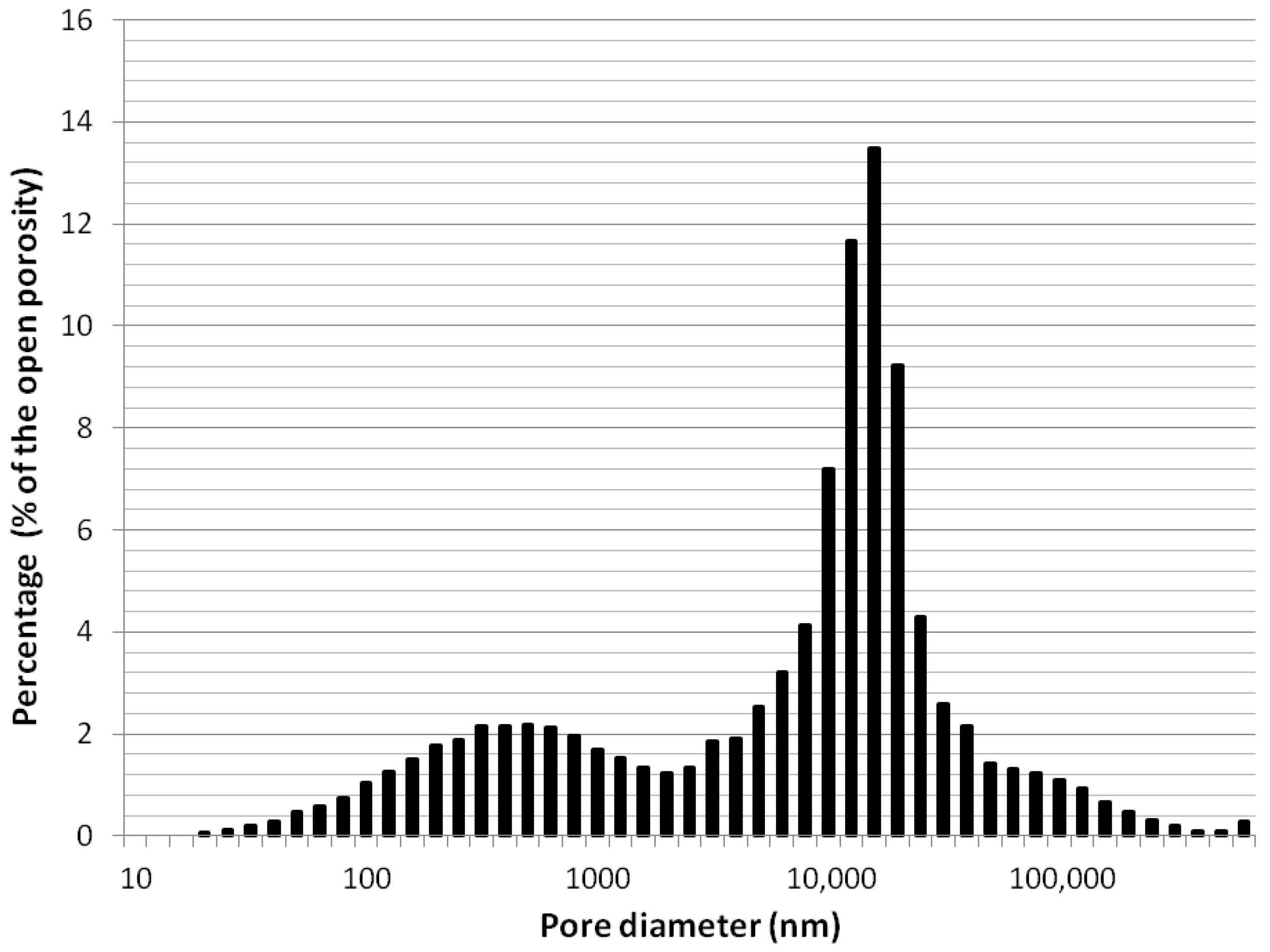



| Antipluviol S | Funcosil SNL | |
|---|---|---|
| Consistency | liquid | liquid |
| Colour | transparent | transparent |
| Density (at 20 °C) | approx. 0.8 kg·m−3 | 0.78 kg·m−3 |
| Application temperature range | from 5 °C to 30 °C | from 10 °C to 25 °C |
| Consumption for natural stone | 0.1–0.8 kg·m−2 per coat | 0.6–1.2 L·m−2 |
| Number of coat layers | 2 or 3 | min. 2 |
| Penetration depth | 4 mm | no information |
| Curing time | not given | not given |
| Number of Coating Layers | Curing Time | |
|---|---|---|
| 2 Days | 2 Weeks (14 Days) | |
| 2 | 2x/2d | 2x/2w |
| 3 | – | 3x/2w |
| Parameter | Samples | ||||
|---|---|---|---|---|---|
| Untreated | 2x/2d | 2x/2w | 3x/2w | ||
| Water absorption by capillarity NWAC (%) | average | 11.48 | 8.32 | 1.10 | 1.17 |
| max | 11.92 | 8.54 | 1.60 | 1.51 | |
| min | 11.17 | 8.16 | 0.83 | 0.79 | |
| Efficiency coefficient CefWAC (-) | - | 0.73 | 0.10 | 0.10 | |
| Water absorption by complete immersion NWAI (%) | average | 12.16 | 9.57 | 2.63 | 2.74 |
| max | 12.71 | 9.77 | 3.44 | 2.97 | |
| min | 11.83 | 9.31 | 2.33 | 2.23 | |
| Efficiency coefficient CefWAI (-) | - | 0.79 | 0.22 | 0.23 | |
| Sample Series | Sample | m1 (g) | m2 (g) | m3 (g) | m3–m1 (g) | Mean m3–m1 (g) |
|---|---|---|---|---|---|---|
| 2x/2w | H-17 | 234.45 | 235.02 | 234.76 | 0.31 | 0.23 |
| H-18 | 236.40 | 236.93 | 236.64 | 0.24 | ||
| H-19 | 236.33 | 236.77 | 236.44 | 0.11 | ||
| H-20 | 239.30 | 239.88 | 239.57 | 0.27 | ||
| 3x/2w | H-29 | 238.41 | 238.98 | 238.67 | 0.26 | 0.22 |
| H-30 | 239.45 | 239.99 | 239.68 | 0.23 | ||
| H-31 | 242.36 | 242.92 | 242.55 | 0.19 | ||
| H-32 | 236.86 | 237.42 | 237.07 | 0.21 |
| Parameter | Samples | ||||
|---|---|---|---|---|---|
| Untreated | 2x/2d | 2x/2t | 3x/2t | ||
| Water absorption by capillarity NWAC (%) | average | 11.48 | 11.55 | 9.25 | 8.98 |
| max | 11.92 | 11.86 | 9.95 | 9.61 | |
| min | 11.17 | 11.20 | 8.79 | 7.81 | |
| Efficiency coefficient CefWAC (-) | ˗ | 1.0 | 0.82 | 0.79 | |
| Water absorption by complete immersion NWAI (%) | average | 12.16 | 12.01 | 11.70 | 11.49 |
| max | 12.71 | 13.28 | 12.10 | 11.76 | |
| min | 11.83 | 9.59 | 11.47 | 11.15 | |
| Efficiency coefficient CefWAI (-) | ˗ | 0.99 | 0.96 | 0.94 | |
| Sample Series | Sample | m1 (g) | m2 (g) | m3 (g) | m3–m1 (g) | Mean m3–m1 (g) |
|---|---|---|---|---|---|---|
| 2x/2w | H−21 | 240.29 | 240.72 | 240.26 | −0.03 | −0.07 |
| H−22 | 237.39 | 237.82 | 237.39 | 0 | ||
| H−23 | 235.00 | 235.33 | 234.84 | −0.16 | ||
| H−24 | 236.87 | 237.23 | 236.79 | −0.08 | ||
| 3x/2w | H−33 | 238.53 | 238.89 | 238.36 | −0.17 | −0.1 |
| H−34 | 233.09 | 233.49 | 232.99 | −0.1 | ||
| H−35 | 241.57 | 241.93 | 241.47 | −0.1 | ||
| H−36 | 238.01 | 238.40 | 237.98 | −0.03 |
Disclaimer/Publisher’s Note: The statements, opinions and data contained in all publications are solely those of the individual author(s) and contributor(s) and not of MDPI and/or the editor(s). MDPI and/or the editor(s) disclaim responsibility for any injury to people or property resulting from any ideas, methods, instructions or products referred to in the content. |
© 2024 by the authors. Licensee MDPI, Basel, Switzerland. This article is an open access article distributed under the terms and conditions of the Creative Commons Attribution (CC BY) license (https://creativecommons.org/licenses/by/4.0/).
Share and Cite
Dunčková, L.; Durmeková, T.; Adamcová, R. Factors Affecting the Efficiency of Hydrophobic Coatings—Experience from Application on Sandstone. Appl. Sci. 2024, 14, 4541. https://doi.org/10.3390/app14114541
Dunčková L, Durmeková T, Adamcová R. Factors Affecting the Efficiency of Hydrophobic Coatings—Experience from Application on Sandstone. Applied Sciences. 2024; 14(11):4541. https://doi.org/10.3390/app14114541
Chicago/Turabian StyleDunčková, Lucia, Tatiana Durmeková, and Renáta Adamcová. 2024. "Factors Affecting the Efficiency of Hydrophobic Coatings—Experience from Application on Sandstone" Applied Sciences 14, no. 11: 4541. https://doi.org/10.3390/app14114541






